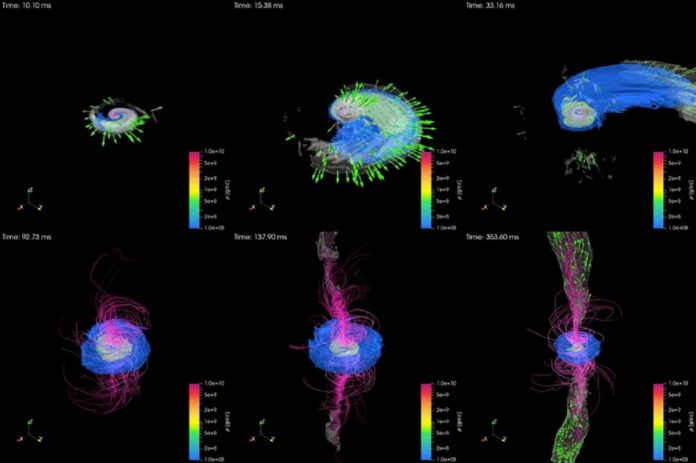In a new study, scientists at the Max Planck Institute for Gravitational Physics in Potsdam and Japan modeled the complete process of colliding a black hole with a neutron star. They estimated the entire process, starting with the final orbits and continuing through the merger and post-merger period, when high-energy gamma-ray bursts may happen.
In particular, they chose two different model systems that involve a rotating black hole and a neutron star. They set 1. masses of the black holes at 5.4 and 8.1 solar masses and 2. mass of neutron star as 1.35 solar masses.
They set these parameters because the neutron star could be expected to be torn apart by tidal forces.
The simulation offers significant insights into a process that lasts one to two seconds. It may sound too short, but lots happen within that moment: from the final orbits and the disruption of the neutron star by the tidal forces, the ejection of matter, to the formation of an accretion disk around the nascent black hole, and further ejection of matter in a jet.
Masaru Shibata, director of the Department of Computational Relativistic Astrophysics at the Max Planck Institute for Gravitational Physics in Potsdam, said, “This high-energy jet is probably also a reason for short gamma-ray bursts, whose origin is still mysterious. The simulation results indicate that the ejected matter should synthesize heavy elements such as gold and platinum.”
The simulation shows that the neutron star is torn apart by tidal forces during the merger process. Within a few milliseconds, around 80% of the material from the neutron star falls into the black hole, adding one solar mass to its mass. The matter from the neutron star creates a one-armed spiral shape in the next ten milliseconds or so.
The remaining material in the spiral arm (0.2 to 0.3 solar masses) forms an accretion ring around the black hole while some of it is ejected from the system. After the merger, the accretion disc falls into the black hole, creating a focussed jet-like stream of electromagnetic radiation that may eventually result in a brief gamma-ray burst.
Dr. Kenta Kiuchi, group leader in Shibata’s department, who developed the code, said, “It took the department’s cluster computer “Sakura” about two months to solve Einstein’s equations for the process, which takes about two seconds. Such general relativistic simulations are very time-consuming. That’s why research groups worldwide have focused only on short simulations.”
“In contrast, an end-to-end simulation, such as the one we have now performed for the first time, provides a self-consistent picture of the entire process for given binary initial conditions that are defined once at the beginning.”
Journal Reference:
- Kota Hayashi, Sho Fujibayashi et al. General-relativistic neutrino-radiation magnetohydrodynamic simulation of seconds-long black hole-neutron star mergers. Phys. Rev. D 106, 023008 – Published 8 July 2022. DOI: 10.1103/PhysRevD.106.023008
